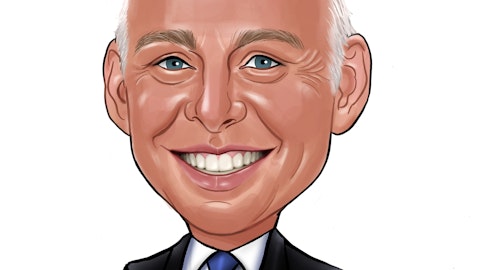Reinsurance Group of America, Incorporated (NYSE:RGA) Q4 2022 Earnings Call Transcript February 3, 2023
Operator: Good day, and welcome to the Reinsurance Group of America Fourth Quarter 2022 Earnings Conference Call. All participants will be in a listen-only mode. Please note this event is being recorded. I would now like to turn the conference over to Todd Larson, Senior Executive Vice President and Chief Financial Officer. Please go ahead.
Todd Larson: Thank you. Welcome to RGA’s Fourth Quarter 2022 Conference Call. I am joined on the call this morning with Anna Manning, RGA’s Chief Executive Officer; Leslie Barbi, our Chief Investment Officer; Jonathan Porter, our Chief Risk Officer; and Jeff Hopson, Head of Investor Relations. A quick reminder before we get started regarding forward-looking information and non-GAAP financial measures. Some of our comments or answers to your questions may contain forward-looking statements. Actual results could differ materially from expected results. Please refer to the earnings release we issued yesterday for a list of important factors that could cause actual results to differ materially from expected results. Additionally, during the course of this call, information we provide may include non-GAAP financial measures.
Please see our earnings release, earnings presentation and quarterly financial supplement, all of which are posted on our website for a discussion of these terms and reconciliations to GAAP measures. And now I’ll turn the call over to Anna for her comments.
Anna Manning: Good morning, and thank you for joining our call. Last night, we reported adjusted operating earnings for the fourth quarter and full year of $2.99 per share and $14.43 per share, respectively. This was a solid quarter that included favorable performance across many of our segments and business. Areas of particular strength this quarter include our Global Financial Solutions business in all regions and product lines, Asia Pacific Traditional and U.S. Group and Individual Health. We continue to see very good new business activity and momentum with notable premium growth on a constant currency basis. Our product development capabilities, capital solutions and underwriting expertise are particular strengths that serve as valuable differentiators and are leading to first-to-market and exclusive new business opportunities.
Our overall investment performance was good and the quarter saw minimal impairments. This was also a solid quarter for capital deployment with $80 million deployed into in-force and other transactions across a range of geographies and product lines, which brings the year-to-date total to $430 million, another successful year. The transaction pipelines remain very active and broad based across our many risks and geographies and we expect the strong demand to continue. As I look back on 2022, I am proud of our many accomplishments. First, we achieved record adjusted operating EPS of $14.43, despite absorbing $5.02 of COVID-19 claims and $0.53 of foreign currency headwinds, demonstrating the strength of the underlying earnings power of our business.
Second, our client-centric solutions-oriented strategy is driving good quality new business opportunities. Third, global non-COVID underwriting experience was favorable led by our U.S. Individual Mortality Business and our Asia Pacific Traditional segment. Fourth, Global Financial Solutions had another record performance here. We completed many transactions at attractive returns, adding to the substantial underlying earnings power and the diversification of our business. Fifth, investment results were favorable, in part benefiting from higher available yields and some nice realized gains on our real estate joint ventures and limited partnerships. Interest rates have shifted from a multiyear headwind to a tailwind, and we are seeing a measurable benefit.
And finally, I am proud of the progress we made on our ESG efforts. In 2022, we published our first sustainability report, providing transparency into our ESG strategy targets and accomplishments and demonstrating our ongoing commitments. But as proud as I am of these accomplishments, I am even more excited about the future. The life insurance industry delivered on its purpose during the course of the last three years and RGA demonstrated its leadership position and the strength of our business and long-term client partnerships. We have a great franchise, have highly engaged and talented teams and are very well positioned in all our markets. Our business is resilient, our strategy is delivering value to our clients and returns to our shareholders and I am optimistic about our future growth prospects.
After 17 years with RGA and more than 42 years in the insurance industry, I will be retiring at the end of 2023. As you’ve heard me say over many years, one of our key strengths is the depth and breadth of our leadership team and that was certainly highlighted with the recent announcement that Tony Cheng, who has been with RGA for more than 25 years, was named President and will become CEO on January 1, 2024,upon my retirement. Tony besides being a very capable and talented executive has played an instrumental role in the growth of our business in Asia and more recently, in his leadership role overseeing EMEA and Australia. He understands and appreciates our many strengths and our unique culture and I am confident that RGA will be in great hands.
Thank you for your interest in RGA. And I’ll now turn it over to Todd to review the detailed financial results.
Todd Larson: Thanks, Anna. RGA reported pretax adjusted operating income of $245 million for the quarter and adjusted operating earnings per share of $2.99, which includes the COVID-19 impact of $0.78 per share and a foreign currency headwind of $0.22 per share. For full year, we reported record adjusted operating earnings per share of $14.43, which includes the COVID-19 impact of $5.02 per share and a foreign currency headwind of$0.53 per share. The trailing 12 months adjusted operating return on equity was 10.3%, which is net of estimated COVID-19 impact of 1.5%. We are pleased with the solid quarterly results produced across the organization and in other fundamental metrics such as new business production, constant currency premium growth, capital deployed into in-force and other transactions and investment returns.
For the full year, our book value per share excluding AOCI, grew 4.8% to $146.22. This was achieved after absorbing $447 million of COVID-19 claim impacts. Reported premiums were up 1.1% for the quarter after adjusting for adverse foreign currency impacts, premiums were up 6% on a constant currency basis. For the full year, premiums totaled $13.1 billion representing an increase of 8.4% on a constant currency basis. We continued to see good momentum across our various business segments. Turning to the quarterly segment results, starting on Slide 7 in our earnings presentation that can be found on RGA’s Investor Relations website, the U.S. and Latin America Traditional segment results reflected both unfavorable Individual Mortality experience and COVID-19 claims that totaled approximately $48 million.

Photo by Scott Graham on Unsplash
We believe some of the excess mortality relates to the early flu season. Jonathan will provide some additional insights in a minute. Variable investment income was a positive contribution, although below the recent runrate. The U.S. Individual Health Business had favorable experience and our Group business results were above our expectations as most lines performed well. The U.S. asset-intensive business results were strong reflecting favorable investment spreads and our Capital Solutions business continues to be within our expectations. The Canada Traditional results reflected unfavorable experience in the group life and disability business with COVID-19 claim costs totaling $3 million. The Financial Solutions business was above expectations due to favorable longevity experience.
In the Europe, Middle East and Africa segment, the traditional business results were in line with expectations, reflecting unfavorable mortality in the UK, offset by favorable overall experience otherwise. COVID-19 claim costs were $2 million for the quarter. EMEA’s Financial Solutions business results reflected modestly favorable experience. Turning to our Asia Pacific Traditional Business, Asia results reflected favorable underwriting experience across the region, absorbing COVID-19 claim cost of $13 million. Australia reported another good quarter with a pretax profit of $6 million driven by favorable group experience. The Asia Pacific Financial Solutions business results were very strong, reflecting strong new business and favorable investment spreads.
We also saw a decline in the COVID-19 costs related to medical hospitalization claims in Japan. The Corporate and Other segment reported a pretax adjusted operating loss of $89 million, higher than our expected quarterly range due to higher general expenses and some elevated financing costs. Included in the higher general expenses are some incentive compensation true-ups, consulting fees and a number of one-off items. Moving on to investments on Slide 13 through 15 in our earnings presentation, the non-spread portfolio yield for the quarter was 4.45%, reflecting a positive contribution from variable investment income, although lower than the recent run rate. The quarter was also positively impacted by higher new money rates, as well as some benefit from existing floating rate securities.
For non-spread business, our new money rate was 5.05% in the quarter, compared to 3.31% in the fourth quarter of last year. Our new money rate was modestly lower than the third quarter due to a more conservative asset allocation of new money and some lower spreads available. Looking at the base yield before variable investment income, we have moved from 3.78% in the fourth quarter of last year to 4.14% in this quarter. Meanwhile, credit impairments were minimal, and we believe the portfolio is well positioned as we move through a more uncertain economic environment. We have taken action recently to lower our high-yield bond exposure. We have also selectively extended duration to lock in higher interest rates. As shown on Slide 16 and 17 of our earnings presentation, our capital and liquidity position remains strong and we ended the quarter with excess capital of approximately $1.2 billion.
In the quarter, we deployed $80 million of capital into in-force and other transactions and continue to see a very active deal pipeline. We also returned a total of $78 million of capital to shareholders through share repurchases and dividends. For the full year, we deployed $430 million of capital into in-force and other transactions and returned $280 million of capital to shareholders through share repurchases and dividends. As we emerge from the pandemic and a strong 2022, we are confident in our earnings power and capital generation and we expect to be active in the deploying of capital into in-force and other transactions and returning excess capital to shareholders through dividends and share repurchases. We have included some updated LDTI information in the earnings presentation on Slide 21.
The LDTI adjustments as of January and December of 2021 are consistent with our previously provided ranges. As of September 30, 2022, we estimate a decrease in retained earnings of $500 million to $800 million after tax, compared to current financial reporting. We estimate an increase of AOCI of $2.1 billion to $4.1 billion, reflecting the higher interest rate environment. As we have previously commented, we believe the new financial reporting standard will provide better insight into RGA’s long-term performance and along with the new disclosures provide additional transparency of our business to investors. We are excited about the future and believe our well-diversified global platform and underlying earnings power positions us to continue to support our clients and deliver attractive financial returns to shareholders over time.
I will now turn the call over to Jonathan Porter, our Chief Risk Officer.
Jonathan Porter: Thanks, Todd. As indicated on Slide 8, aggregate non-COVID-19 underwriting experience was modestly unfavorable in the quarter. We continue to benefit from globally diversified book of risks, as higher claims in some markets were in large part offset by favorable underwriting experience in others. Total COVID-19 impacts continue to remain moderate, totaling $70 million pretax across all segments. Starting first with U.S. Individual Mortality, we experienced elevated non-COVID-19 claim costs due to higher claims frequency. Large claim experience was in line with our expectations after two very favorable quarters inQ2 and Q3. Our higher frequency of claims is directionally consistent with the excess levels of U.S. general population mortality as reported by the CDC.
Non-COVID-19 population deaths continue to remain elevated, which was compounded by the first material influenza season since the start of the pandemic. Although total flu cases and estimated mortality appear to be in line with an average pre-pandemic flu season, influenza cases peaked about 8 to 10 weeks earlier than historic norms, which we believe shifted the majority of deaths into the fourth quarter. U.S. general population data continues to show COVID-19 deaths are primarily at ages above 65, where there is less life insurance exposure. In the quarter, in our U.S. Individual Mortality business, estimated COVID-19 claim costs of $44 million, which is $13 million per 10,000 general population deaths was at the lower end of our rule of thumb range.
Aggregate underwriting results in all other markets were favorable, driven by strong performance across Asia. As expected, we saw the material quarter-over-quarter reduction in medical claim costs in Japan to $11 million consistent with the narrowing of eligibility for at-home COVID-19 claims reimbursement that occurred at the end of September. Turning to Slide 10 in the earnings presentation, our overall year-to-date non-COVID-19 underwriting results were strong. U.S. Individual Mortality had both favorable large claims experience and lower overall claims frequency and Asia Pacific Traditional also had very positive underwriting results across the region. U.S. Individual Health and U.S. Group results were ahead of expectations and Global Financial Solutions underwriting results were also positive, primarily due to better-than-expected longevity experience.
These favorable results were partially offset by unfavorable mortality experience in Canada and the UK due to both higher frequency and severity. Full year COVID-19 claim costs of $447 million with the majority of U.S. Individual Mortality was a substantial decrease from 2021. That concludes our prepared remarks. We would now like to open it up for questions.
See also 10 Most Undervalued Solar Stocks to Buy and 12 Most Undervalued Travel Stocks To Buy .
Q&A Session
Follow Reinsurance Group Of America Inc (NYSE:RGA)
Follow Reinsurance Group Of America Inc (NYSE:RGA)
Operator: The first question today comes from Jimmy Bhullar with JPMorgan. Please go ahead.
Jimmy Bhullar: Hey, good morning. I had a question first on just capital deployment. Should we assume sort of a similar allocation between deals and buybacks this coming year as you’ve had in the past year?
Todd Larson: This is Todd. So it will be somewhat dependent on the level of deal activity that we see. And right now, the pipeline looks very active around our different geographies and I think if you look back historically, it’s we’ve pulled all the different levers between capital deployment into the transactions, the share buybacks and dividends and I think you’ll see us continue that going forward, but we do intend to be active to the extent there are not attractive transactions to deploy the capital, we will look to bring down that excess capital level over time through share repurchases and the dividend level.
Jimmy Bhullar: And have you do you see a similar environment in terms of competition for deals? Because it seems like in the non-mortality like asset-intensive businesses, there’s just a lot more interest in those blocks from companies backed by alternative asset managers.
Anna Manning: Thank you for the question, Jimmy, it’s Anna. First, let me shape out the pipeline. As Todd mentioned, our pipelines are very good. Strong demand across everything that we do and right across our geographies and various regions. Now from a competitive environment, yes, steel environment is competitive. It varied by size and it varies by the underlying risks, so we typically will see and do see less competition when there are more complex elements of the deal or as you mentioned, when there is more insurance risks, these biometric risks and also, we tend to see less competition on the larger size deals. Now in terms of our competitive positioning, the way I think about it, Jimmy, is really our proposition is all about bringing a complete package to the table.
It’s in part how we differentiate from our competitors, so the package, including we have an excellent brand. We have a reputation for getting things done from being creative for finding new solutions, and we also have a reputation on delivering. We honor and meet our commitments. And we have very long and strong, well-established client relationships to add the strength of RGA’s counterparty and our long-term commitment to this business, that’s a pretty complete package and that’s how we compete and that’s how we win deals. And you’ve seen that time and time again, you’ve seen it through the entire time of the pandemic and our approach is really to prioritize and pick our sweet spots and we expect to continue to be competitive, be active and be successful.
Operator: The next question comes from John Barnidge with Piper Sandler. Please go ahead.
John Barnidge: Thank you, very much. Premium growth in Asia declined I know there is some 4Q true-ups that occurred last year given elevated mortality that did this time, fortunately. Now that we are arriving at a period of general improved mortality, how should we be thinking about this impacting premium growth given that dynamic in Asia going forward, but also in other geographies? Thank you.
Anna Manning: Thank you for the question. I’ll start. I would say the dynamics in Asia also reflected that in some markets through most of 2022, there were still COVID-related restrictions that were being that were causing new business to be at lower levels than we had seen historically. Most, if not all, those restrictions have now been lifted, so we see momentum really picking up. In terms of growth globally, as I think about growth for our traditional business, we are driving a fair amount of that growth with the work we do with our clients on new underwriting programs. Things like simplified issue or accelerated or automated programs. But it’s not just these programs, it’s also providing the underwriting services for cases that are rejected or fall out of the programs.


